
by Jay R. Thompson Wednesday, January 2, 2013
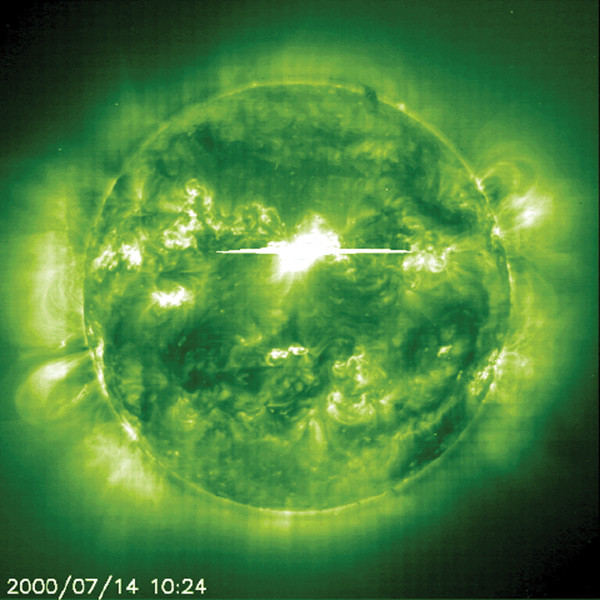
A powerful solar flare recorded on July 14, 2000, by the Solar and Heliospheric Observatory (SOHO) satellite. The bright spot near the center is a flare, which was classified an X-5, among the most powerful. X-class flares, the largest class, can trigger planet-wide radio blackouts and long-lasting radiation storms. SOHO (ESA & NASA)
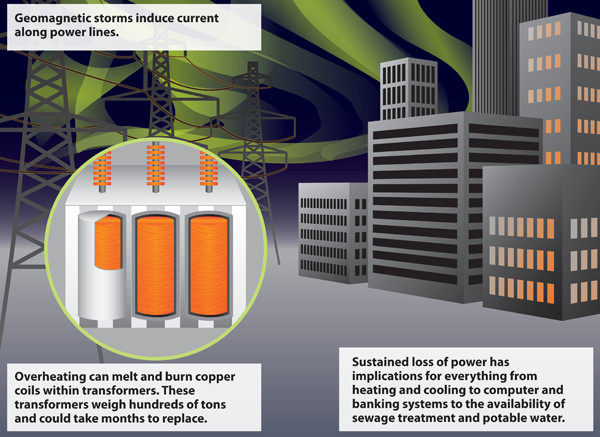
Kathleen Cantner, AGI
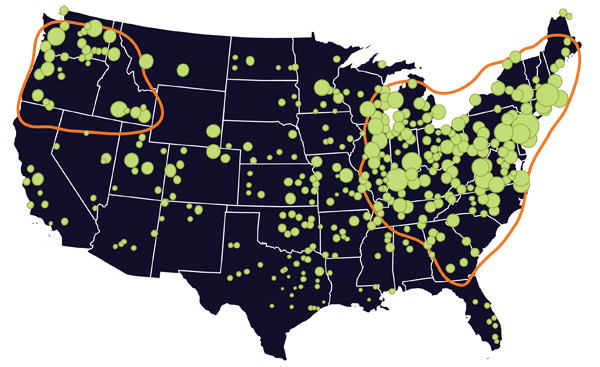
Orange outlines highlight the areas in the U.S. that are most vulnerable to electrical outages due to a severe geomagnetic storm, according to a 2008 report from the National Research Council. Kathleen Cantner, AGI
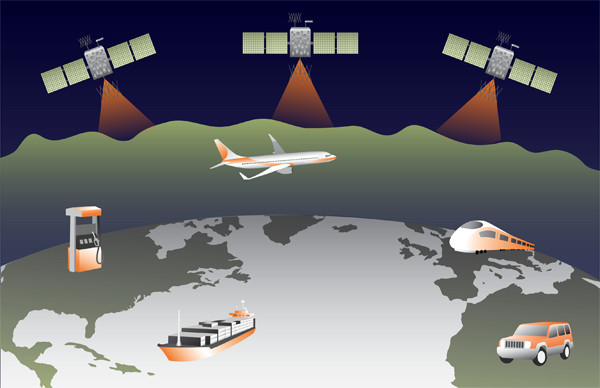
The transmission of radio signals between Earth and GPS satellites, which are vital for transportation, can be disrupted by the ionizing effects of X-rays and extreme ultraviolet light emitted by solar flares. Kathleen Cantner, AGI
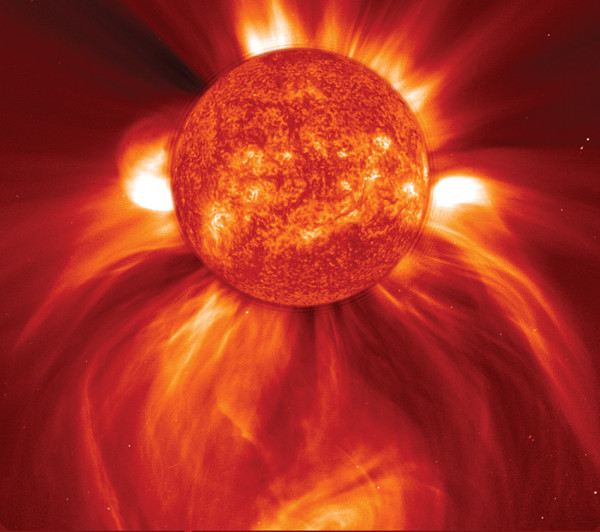
This image, taken Jan. 8, 2002, by the Solar and Heliospheric Observatory's (SOHO's) LASCO C2 instrument, shows a widely spreading coronal mass ejection blasting more than a billion tons of matter out into space at millions of kilometers per hour, with a superimposed image of the sun from SOHO's Extreme-ultraviolet Imaging Telescope. SOHO (ESA & NASA)
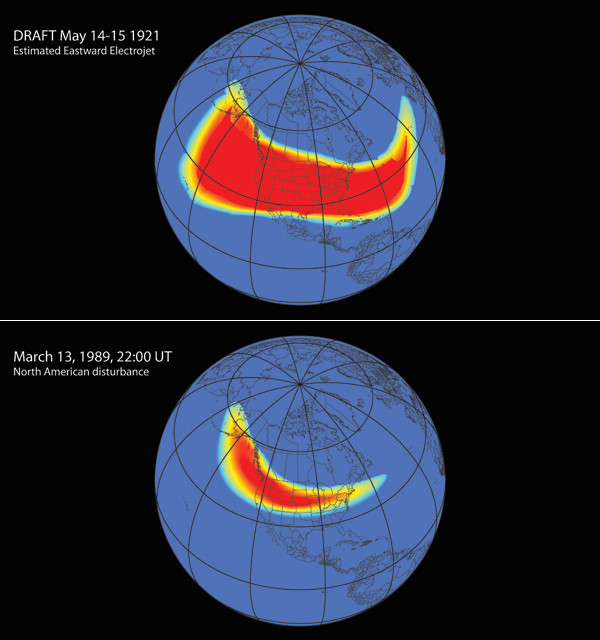
Global projections of ground-level magnetic field disturbances during the May 1921 (top) and March 1989 (bottom) geomagnetic storms. The 1989 event left 6 million people in Quebec without power. Courtesy of Storm Analysis Consultants
In last month’s issue of EARTH, we explored what is known about solar activity, the sun and its interaction with Earth. This month, we examine the possible effects of solar activity and the vulnerability of power grids and satellites, as well as what is being done to reduce that vulnerability.
Were a massive solar storm to strike Earth, the impacts could rival or exceed the worst natural disasters humans have ever faced.
“Let’s just posit for the moment that we lost power in a large region of the United States for a few months or years. Immediately, most commerce shuts down. A few shops might be open and use cash, but as a general rule commerce stops immediately,” says Richard Andres, program director of Energy and Environmental Security Policy at National Defense University in Washington, D.C.
Some states have legislation mandating that gas stations maintain backup generators, but most U.S. gas pumps would stop as soon as power is lost. Likewise, fuel pipelines would, for the most part, stop working. ATMs would go down. A few hours later, both land phone lines and cell phones would fail. “Most cities now pump water instead of using gravity flow, so in a few hours or more, water would stop pumping.” Wastewater treatment would also shut down, and sewage could overflow into drinking water. This is only the beginning of a worst-case scenario that Andres and others envision, and are trying to prevent.
About three days into the blackout, household pantries would begin to thin out, as would the population’s patience. People would try to leave affected areas, but wouldn’t be able to fuel their cars. Those with health problems would soon lose access to medicine. “Emergency facilities mostly have generators, so hospitals [would] have power for a few days,” Andres says, but they would eventually lose electricity too, when their limited fuel supplies run out.
“About five days into the situation, police, firefighters and other emergency responders [would] start to leave their jobs to go home and protect their families — this is what the national guard and law enforcement officials have told us — and people [would] attempt to find food and water wherever they could to feed their families, so we think there would be a breakdown of social order,” Andres says. The workers who operate the power grid could also walk away from their jobs, making restoration even more difficult.
And then there’s the nuclear concern. “Hundreds of Fukushimas,” says John Kappenman, an electrical engineer who has spent decades studying the U.S. power grid’s vulnerability to geomagnetic activity. Nuclear reactors would shut down, and eventually melt down because even their coolant water systems need electricity to continue operating the large pumps needed for cooling the reactor vessels and spent fuel pools. “I wish I could paint a rosier picture, but these are the sort of disaster consequences we need to be honest about and try to do what we can to avoid,” Kappenman says.
Throughout history, humanity has steadily increased its dependence upon technology. While technology has vastly improved the quality of life for billions of people, it has also opened humanity up to new risks and vulnerabilities.
Terrorism and natural disasters might be at the forefront of the minds of policymakers and the U.S. population, but a significant threat lurks over our heads: the sun. A massive solar storm, of the size last seen a century and a half ago, could easily leave hundreds of millions of people in the dark for days, weeks or even months.
The sun follows a roughly 11-year cycle of activity, measured by the number of sunspots on its surface. The solar maximum — when sunspot activity peaks, with a corresponding increase in solar flares and billion-ton blobs of magnetic field-generating solar plasma known as coronal mass ejections (CMEs) launched from the sun’s surface — is forecast to occur later this year. An increase in space weather typically coincides with the solar maximum, bringing changes for Earth’s magnetosphere, ionosphere and thermosphere due to the solar activity.
When Superstorm Sandy plowed into New Jersey and New York last October, it jammed a crowbar into the delicate, high-speed machinery of one of the nation’s most densely populated urban regions. During the storm, subway tunnels were flooded, massive fires burned dozens of homes, and wind, waves and a tidally aided storm surge swept away property and eroded coastlines. Millions of people in several states were left without power or cell phone service for days.
Sandy is a reminder of how massive power outages limit access to resources usually taken for granted. Gas stations, for example, might have plenty of fuel, but it can’t be pumped without electricity. In Sandy’s wake, motorists in New York and New Jersey spent hours in lines to fill up at the few area stations with electricity. Patience ran thin, tempers boiled over and police were called in to maintain order. Meanwhile, stores without power were shuttered, some hospitals without power had to move patients, and cell phone towers were inactive without electricity. A week later, power was mostly restored, and for those who hadn’t suffered damage to their homes or lost family members, life started limping back toward normal.
“Hurricane Sandy provides a demonstration of what could go wrong,” says Kappenman, who worked in the power industry for 20 years, then for Metatech Corporation, a scientific and engineering consulting firm, and is now an independent consultant. After a hurricane, people in affected regions depend on assistance from neighboring, unaffected regions. In the case of a severe geomagnetic storm, there may not be a neighboring unaffected region, Kappenman says. “We are talking about something that could sweep across the entire continent, not a few counties near landfall,” he says.
The yardstick event against which severe space weather is measured occurred 150 years ago. In 1859, the Carrington Event lit up tropical skies with auroras, which normally only occur in high-latitude regions. It also induced currents along telegraph cables, the only long-distance electrical technology at the time, causing sparks, fires and garbled signals that plagued telegraph operators.
The Carrington Event is the single most severe geomagnetic storm to strike the planet in recorded history. If such an event were to occur today — with the sparse web of U.S. telegraph lines now grown into a massive grid of 160,000 kilometers of high-voltage power lines — what might happen?
Understanding space weather isn’t solely a pursuit of knowledge, but a desire for prediction, according to Therese Moretto Jorgensen, a magnetospheric physicist and director of the National Science Foundation’s (NSF) Space Weather Research and Instrumentation Program. For example, she says, “we don’t want atmospheric scientists just to understand tornadoes, we want them to predict: What track is it going to take? What is the wind speed going to be?” We need the same kind of information for solar storms, she says. That information can then be used to harden the weak spots in vulnerable infrastructure.
Although the NSF and other groups fund space weather research, there’s a pitfall along the path toward improvement: Science has a staggering lack of data on the worst that space weather can dish out, Moretto Jorgensen says. The study of solar activity and space weather didn’t intensify until about 50 years ago and the worst known event is still the Carrington Event. What is the risk that another Carrington Event — or a more intense solar storm — will hit? “That’s the $100 million question,” she says. “We have a pretty good handle on” smaller flares and CMEs, but models don’t represent the extreme events well, she says.
The Carrington Event was “prehistoric, in a sense,” says Karel Schrijver, a solar and heliospheric physicist at Lockheed Martin’s Advanced Technology Center in Palo Alto, Calif. In the 154 years since the storm, the power grid has grown immensely, as has our reliance on it, and we don’t know how the grid would be affected by an extreme solar storm, Schrijver says.Joining forces with Lockheed Martin engineer Sarah D. Mitchell, Schrijver has studied routine space weather to get a sense of its economic impact on the U.S. power grid. Although their study has yet to be published, the team’s preliminary numbers suggest space weather creates at least $3 billion a year in repair costs, just from routine events. “It’s a substantial number — it’s more than the nation spends on understanding space weather,” Schrijver says.
Schrijver and Mitchell’s report didn’t address the likely financial impact of severe space weather, but a 2008 report from the National Research Council offered a few staggering numbers: costs of $1 trillion to $2 trillion in the first year alone, with recovery taking between four and 10 years, following a geomagnetic storm as strong as the Carrington Event.
Concern for the U.S. power grid largely focuses on extra-high-voltage (EHV) transformers. EHV transformers weigh hundreds of tons each. Their size and weight make them difficult to transport, sometimes requiring specially made train cars. Many existing transformers are approaching the end of their designed operating lifetimes of 30 to 40 years. All told, the U.S. grid has about 2,000 EHV transformers.
In 2010, while at Metatech Corporation, Kappenman authored a report for Oak Ridge National Laboratory in Tennessee evaluating the threat from geomagnetic storms on the U.S. power grid. Electric currents induced by geomagnetic activity in EHV power lines could cause EHV transformers to overheat, melting copper coils and leads.
Kappenman estimates that a severe geomagnetic storm would take out more than 350 EHV transformers — “a sizable chunk in the grand scheme of things,” he says. “Other data suggest it could be much worse than that.”
The transformers would need to be replaced, but the time needed to build and test a single replacement transformer can be 12 to 15 months, or even longer, depending on the size and manufacturer, Kappenman reported. Most manufacturers are overseas, and transporting the behemoth transformers requires an ocean voyage and special logistics for ground transport by train or truck. Additionally, EHV transformer installation is complex, and would generally take several more days, “with a large, trained crew, in the best of circumstances,” Kappenman wrote.
In addition to the logistical challenges that could arise, it’s not beyond imagining, he says, that the few nations that manufacture large EHV transformers might need them for their own power restoration should such a storm knock out transformers around the planet. If an entire continent or hemisphere were hobbled by a geomagnetic storm, demand for replacements could be overwhelming. “The ability to adapt, to bring in spare parts, to fix the problems, would be absolutely drowned,” Andres says.
Humans have another major technological weakness as well: satellites. Satellites in low-Earth orbit are still in Earth’s atmosphere, and space weather can cause the atmosphere to expand. This means that the lower, denser atmosphere can swell out to where satellites orbit, thereby increasing atmospheric drag and sending spacecraft falling back to Earth, says Antti Pulkkinen, a space weather modeler at NASA’s Goddard Space Flight Center. In addition, a more frequent hazard, Pulkkinen says, is electromagnetic radiation from solar flares; X-ray and extreme-ultraviolet radiation from large flares increases the ionization in Earth’s ionosphere, preventing radio signals from transmitting between satellites and ground stations. Such flares could also disrupt or damage the electronics in spacecraft.
Some satellites have a form of protection. NASA spacecraft observe the sun in real time, and NOAA’s Space Weather Prediction Center, the U.S. military and other government agencies watch the sun as well. When those observers see solar activity that looks like a threat to satellites, they warn satellite operators. “[Operators] can use that information to turn some of their high-voltage instrumentation off,” Pulkkinen says.
Global Positioning System (GPS) satellites are in medium-Earth orbit partially to minimize risk of atmospheric drag. In fact, they’re less vulnerable than other satellites overall, says Tony Russo, director of the National Coordination Office for Space-based Positioning, Navigation and Timing, an interagency office funded through the Department of Transportation. But GPS satellites are still vulnerable to the other hazards of space weather.
Twenty-four satellites are required for the system to operate effectively, but 35 are in orbit (31 active satellites and four backups). “GPS is what we call a robust constellation,” Russo says. The issue is that the extreme precision of GPS is dependent upon radio communications, which can be disrupted by a disturbance in the ionosphere. “The exact time of arrival of the signal is what gives you your accuracy,” he says. “That’s one of the reasons GPS is sensitive to changes in the ionosphere.” Usually, such disruptions only last for a matter of minutes, he says.
Far more worrisome would be if GPS satellites were damaged and the constellation became unusable. Radiation and charged particles from flares and CMEs can corrupt satellite memory or damage solar panels, instruments and other electronics. GPS is immensely important: The energy grid, transportation and commercial sectors all depend upon it, Russo says. “Even agriculture is using it for 24-hour farming,” he says. “We flew airplanes before GPS, and we could tomorrow [without it], but not as efficiently,” Russo says. Air travelers would likely experience more delays and cancellations, he says.
In commerce, GPS is used as a time-synchronizer for automated systems, Russo says. “If you run your ATM card through the pump at the gas station, you’re using GPS to sync up — it’s a cheap and efficient way of doing it,” he says. GPS also helps oceangoing ships avoid dangerous waters, locomotives avoid collisions, and helicopters avoid terrain, he says.
Loss of GPS, whether brief or long term, would have impacts on safety, convenience and the economy. But the power grid remains the most vulnerable infrastructure because of how integrated it is into almost every aspect of modern society.
The most at-risk regions in the U.S. are Alaska, the Pacific Northwest and the Northeast because they are the farthest north, where solar storms are likely to be most severe, Andres says. “It also has to do with geology — how the energy [induced electric fields] is transmitted through the soil,” he says. Igneous rock in particular is highly resistant to electricity, meaning the path of least resistance for geomagnetically induced currents is in any nearby electrical infrastructure rather than the rock itself.
The chances of another Carrington Event are not high, Andres says. “In any one year, maybe 2 or 3 percent,” he says. The impact, however, could be frightening. It’s possible, Andres says, that all of North America could lose the ability to transmit electricity. Or at the very least, it’s possible that such a storm would leave “in excess of 100 million people cut off from electrical power for perhaps weeks, months, extending into years,” Kappenman says. “We are not prepared for dealing with that, and … we really don’t want to find these things out firsthand,” he adds.
One of the first things that should be done is to build community resilience, Andres says. At the local level, action is needed to find alternative power sources to keep hospitals and fire and police stations operating in case of a severe geomagnetic storm, Andres says. Where possible, onsite diesel generators should be provided with fuel that could last weeks to months, Kappenman adds. Local governments also need to find a place where the families of emergency personnel can be kept safe, he says, thereby keeping responders on the job and maintaining order and safety. People then need to take action themselves: As for the household supplies of food, water and medicine, “three days probably isn’t enough,” Andres says. A three-week supply would be better, he says. The one thing to keep in mind is that “fear and panic are never productive,” Andres says. Preparation is key.
Some regions have procedures in place for preventing grid collapse or bringing grids back online quickly, Kappenman says. For example, the PJM Interconnection is a regional transmission organization that coordinates electricity movement and wholesale activities in 13 states and the District of Columbia. PJM has a procedure for preventing grid collapse, as do the New York and New England transmission organizations, Kappenman says. The plans involve reducing long-distance transfer across the grid, and cancelling planned outages scheduled for transformer maintenance, he says. “Very minimal sorts of things,” Kappenman says. None of these procedures has been tested for Carrington-type events or worse, he adds.
Theoretically, parts of the power grid could be disconnected so that the induced current doesn’t reach some EHV transformers. But power producers and grid operators are “contractually prohibited” from halting electricity distribution, Andres says. In addition, there are liability issues. If a power company shut down or disconnected segments of the grid, even to protect transformers, the power company would be legally liable if, say, people in hospitals or nursing homes died, he says. If, on the other hand, the power company were to stay in operation and lose their transformers, at least they couldn’t be sued, he adds. Of course, loss of the transformers might mean that a huge region of the U.S. (or world) could be without power for months or longer. Andres suggests such policies need to be changed, probably at the federal level. “It’s a primary responsibility of the federal government to help prepare for an event like this and mitigate it if it occurs,” he says.
Federally, the most significant action to reduce U.S. vulnerability to space weather occurred in October 2012, when the Federal Energy Regulatory Commission (FERC) proposed a two-step process. First, FERC wants the North American Electric Reliability Corporation (NERC) to create standards that require grid owners and operators to develop procedures to mitigate the impact of geomagnetic storms. Second, FERC proposes that NERC require owners and operators to assess what impacts geomagnetic activity can have on their systems, and then to take action to protect the grid through automated blocking of geomagnetically induced currents, isolation of difficult-to-replace hardware, and other actions.
The comment period for the proposal ended in December, and if the proposal is approved by FERC, NERC will have 90 days to implement the first step, and six months to implement the second step. Though there is no deadline for action on FERC’s part, Kappenman sees an unusual urgency in the commission’s proposal, and he suspects FERC will approve the order in early 2013. “The good news is that there is a change in policy,” Kappenman says. “That being said, it took us 50 years to get into this problem,” he says. “We can’t get out of it overnight.”
What else could the federal government do in a worst-case scenario? The U.S. Department of Homeland Security (DHS) has a plan for geomagnetic storm outages, Andres says. The plan varies based on the specific situation, but the framework of the plan is as follows: DHS reports the incident to the president, who then develops a plan of action. “This usually involves coordinating with industry through NERC and with various federal and government agencies to respond,” he says. “DHS mainly plays a coordinating role, FEMA and National Guard units provide emergency services, and private industry is responsible for getting power up and running.” Such a plan, however, is for any power outage caused by a geomagnetic storm, but no plan exists for a massive, regional outage, Andres says.
To be fair to Homeland Security, Kappenman says, “there really is nothing we can do if a continent-wide event were to occur. There is no disaster-response scenario we can put in place that could fix something that big.” Hence, the importance of the FERC action — prevention of a massive grid failure — would be far better than trying to recover from one, Kappenman says.
Finally, at the international level, the vulnerability of infrastructure to space weather is not being ignored either. U.S. President Barack Obama and U.K. Prime Minister David Cameron have cultivated what’s being billed as a “space weather partnership” through meetings between the two leaders in May 2011 and March 2012. In June 2012, NOAA and the U.K. Government Office for Science jointly announced an agreement to strengthen collaboration between the two nations’ science communities in an effort to further protect their infrastructure against damage from space weather.
What remains is an uphill race against the unknown. Though scientists, engineers and government officials are talking about the space weather threat and some actions are being taken, the danger of an extreme geomagnetic storm is immense and the scientific capacity to forecast space weather is distinctly limited. Individual models and research may not perfectly predict the specific details of exactly what will happen and when, but the scientific consensus is that the threat is real and that we need to take action immediately because we have no idea when the next big one might strike.
© 2008-2021. All rights reserved. Any copying, redistribution or retransmission of any of the contents of this service without the expressed written permission of the American Geosciences Institute is expressly prohibited. Click here for all copyright requests.